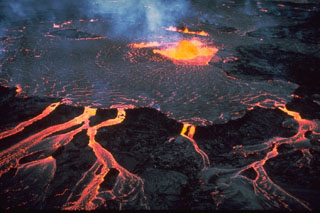Report on Kilauea (United States) — 9 July-15 July 2025
Smithsonian Institution / US Geological Survey
Weekly Volcanic Activity Report, 9 July-15 July 2025
Managing Editor: Sally Sennert.
Please cite this report as:
Global Volcanism Program, 2025. Report on Kilauea (United States) (Sennert, S, ed.). Weekly Volcanic Activity Report, 9 July-15 July 2025. Smithsonian Institution and US Geological Survey.
Kilauea
United States
19.421°N, 155.287°W; summit elev. 1222 m
All times are local (unless otherwise noted)
The Hawaiian Volcano Observatory (HVO) reported that the eruption within Kilauea’s Kaluapele summit caldera, characterized by episodic fountaining and intermittent spatter at two vents along the SW margin of Halema’uma’u Crater, continued at variable levels during 9-15 July. Cycles of minor lava spattering, lava jetting, and gas flames were visible during 7-8 July. Activity increased at 0410 on 9 July with a large lava overflow and fountaining at the N vent. At 0515 the lava fountains became higher and more vigorous, rising to 365 m. Eruption plumes consisting of gas, ash, and Pele’s Hair, rose above the ground and drifted SW. According to the Washington VAAC ash plumes visible in satellite images at 0626 and 0706, and in webcam images, drifted about 55 km W at 3 km (10,000 ft) a.s.l., and then at 1236 a gas-and-steam plume with minor amounts of ash drifted about 37 km SW. Lava flows covered a portion of the crater floor, advancing about halfway across the floor by 1100 based on a helicopter overflight. The fountain occasionally fanned out from the vent and was sometimes bifurcated near the top. After nine hours of continuous fountaining, of which eight were high fountaining, the N vent stopped erupting at 1320. The growing cone around the N vent began to connect with the top of the surrounding caldera wall in some places. No activity at the S vent was observed and it was completely covered by new deposits. After the fountaining episode had ended geologists inspected the tephra deposit SW of the eruptive vents, in the closed area of Hawai’i Volcanoes National Park. They noted that the tephra continued to accumulate, building a mound more than 25 m high and covering parts of Crater Rim Drive. During 10-15 July slumping of the eruptive cone around the vent area was apparent in webcams as it exposed significant incandescent material. The Volcano Alert Level remained at Watch (the third level on a four-level scale) and the Aviation Color Code remained at Orange (the third color on a four-color scale).
Geological Summary. Kilauea overlaps the E flank of the massive Mauna Loa shield volcano in the island of Hawaii. Eruptions are prominent in Polynesian legends; written documentation since 1820 records frequent summit and flank lava flow eruptions interspersed with periods of long-term lava lake activity at Halemaumau crater in the summit caldera until 1924. The 3 x 5 km caldera was formed in several stages about 1,500 years ago and during the 18th century; eruptions have also originated from the lengthy East and Southwest rift zones, which extend to the ocean in both directions. About 90% of the surface of the basaltic shield volcano is formed of lava flows less than about 1,100 years old; 70% of the surface is younger than 600 years. The long-term eruption from the East rift zone between 1983 and 2018 produced lava flows covering more than 100 km2, destroyed hundreds of houses, and added new coastline.
Sources: US Geological Survey Hawaiian Volcano Observatory (HVO), Washington Volcanic Ash Advisory Center (VAAC)

